By Eric Vandenbroeck and co-workers 2
February 2020
According such articles like among those in Foreign
Affairs and The
New European they have decided who is the most dangerous man in the world.
And Andrew S. Weiss vice president for studies at the Carnegie
Endowment, where he oversees research in Washington and Moscow on Russia and
Eurasia referring to Aleksandr Dugin wrote an investigative article
titled; With Friends Like These: The
Kremlin’s Far-Right and Populist Connections in Italy and Austria.
Already in January
2020, the Italian weekly L’Espresso revealed that one of the three Russian
individuals who met, in 2018, with the functionaries of the Italian Lega to
discuss financial support for the far-right party was an actual intel officer
Andrey Kharchenko. Kharchenko is also closely connected to Russian fascist
Alexander Dugin, which means that Russian intelligence services are overseeing
Dugin's activities.
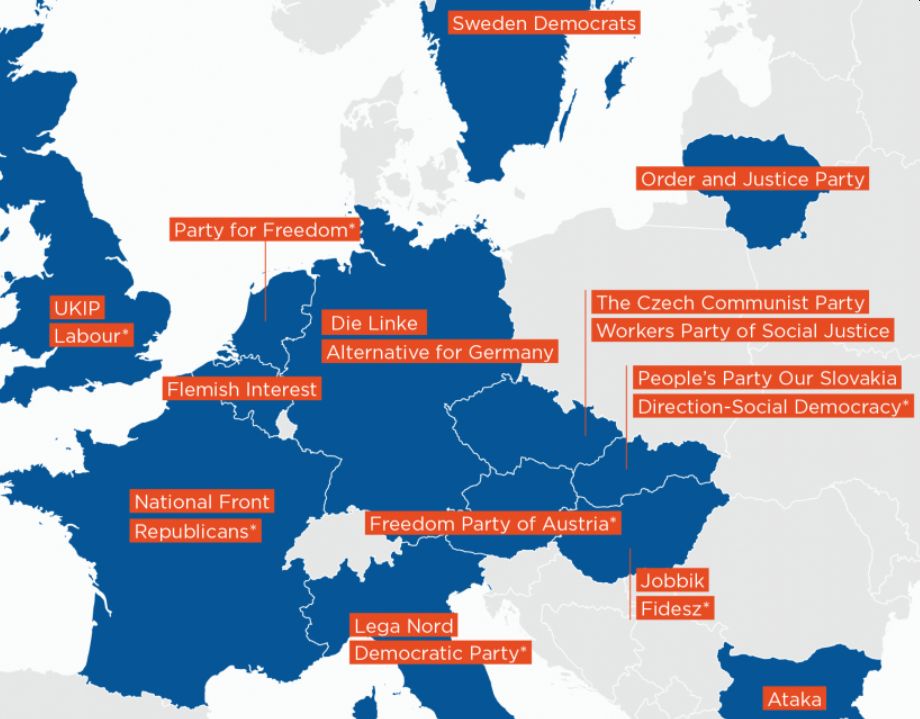
Putin's brain or simply the poster boy of populism and
the radical right?
Whereby Foreign
Affairs called him "Putin's
brain" at the launch of the neo-Eurasian movement we are about to
explain, it is true that the then-Russian deputy foreign minister, Victor
Kalyuzhny, and the deputy speaker of the Russian senate, Alexander Torshin, were listed as members of its higher council we
have to see these matters in a differentiated manner.
Aleksandr Dugin with
a Kalashnikov in front of a tank of the South Ossetian insurgent army, June
2008:

Der Spiegel reported
how Alexander Dugin had set thirty army tents housed his 200 attendees
undergoing paramilitary training.
To place this in a
larger context, Russian geopolitical thinking with deep roots in history has
always influenced its foreign policy - under the Soviet regime, it was
disguised. Only after August 1991 was geopolitics officially accepted as a
political doctrine. Neo-Eurasianism became the most important and influential version of it.
This anti-Western theory had its roots in Eurasianism,
a theory introduced by Russian émigrés. It was based on two conceptions: the Russian view of a declining West and its
conspiracy theory. The first-mentioned view has its precursors even in the West
in Oswald Spengler's writings as well as in the national socialists' worldview.
However, the above
view of the decrepit West has always been combined with the so-called
conspiracy theory. The West is a hotbed of evil forces conspiring against
Russia. In plain language, all misfortunes and shortcomings in Russia's history
can be explained as caused by the West dominated by Jews and Masons...
While more than the
older Slavophiles, Dugin's intellectual forebears are often Western New Right
thinkers such as the Belgian neo-Fascist Jean
Francois Thiriart and, most
importantly, Julius Evola.
It is known that
during his time in Vienna, and upon his return to Italy, Julius Evola's plan
was that of creating a political movement bound more firmly (than had
henceforth been the case; i.e., with Fascism and Nazism) to the principles of
aristocracy and honor, which are the foundation of traditional power. This idea
was shared by some Fascist intellectuals, whereby Evola himself pointed out in
the postwar period, it was a matter of forming elites of young people who knew
how to resist modernity and the false temptations of populism, but above all of
being able to complete the Fascist and Nazi revolutions on a supranational
level by conferring them with cultural meaning.
The issue of
esotericism was also relevant in the context of Evola's collaboration with the
German Sicherheitsdienst (Security Service) and Abwehr (Military Intelligence
Service) because his relationship with the German military secret services took
place given the preparation of a model of man and society that was not intended
for everyone but rather only for the "initiates” who were capable of
demonstrating an inner equilibrium and knowledge superior to others.1
For Dugin, “Fascism
has nothing in common with extreme nationalism, a nationalist radicalism at the
border of chauvinism and racial hate. Despite the existence of a racist and
chauvinistic aspect in German National-Socialism, this element was not defining
the core of the ideology.” According to him. The Ahnenerbe,
the main institution in charge of elaborating Nazi esoteric myths and rituals,
was the model of this nonracist Nazism. It welcomed cooperation with
non-European peoples from Asia and the Middle East. They were considered part
of a shared Aryan genealogy, Only the Atlanticist line of Nazism advanced by
Bavarian circles and by Hitler himself promoted theories of racial destruction.
In contrast, the Russophile Eurasianist line, led by Reinhard Heydrich, was
open to non-European peoples.
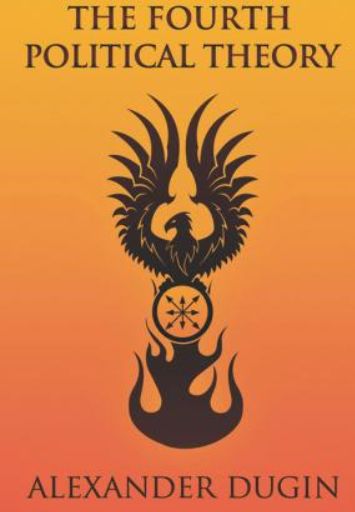
In one of his first
trips to Europe, in 1993, Dugin also met Leon Degrelle
just before the latter passed away. Degrelle, founder
of the Fascist Walloon party Rexism that supported
total collaboration with the Nazis, became Volksführer
of Wallonia and the leader of the Walloon contingent of the Waffen SS, which
was sent to the Eastern Front.
One of Dugin’s
disciples, Nina Kouprianova, is married to white
nationalist leader Richard Spencer. Kouprianova has translated
Dugin’s works which were published by Spencer’s publishing house,
the Washington Summit Publishers. Spencer himself, before he came to the
public eye, has been hosted on RT regularly as a
commentator. More recently, Aleksandr Dugin has also been platformed
on Infowars [archive], run by far-right conspiracy theorist Alex Jones.
We
covered Richard Spencer in reference to the great replacement
conspiracy theory (when he marched chanting
'Jews will not replace us’), whereby he rejecting being a neo-Nazi and
said that he perceived himself closer to the tradition of Alain de
Benoist, Dugin, and the French New Right.
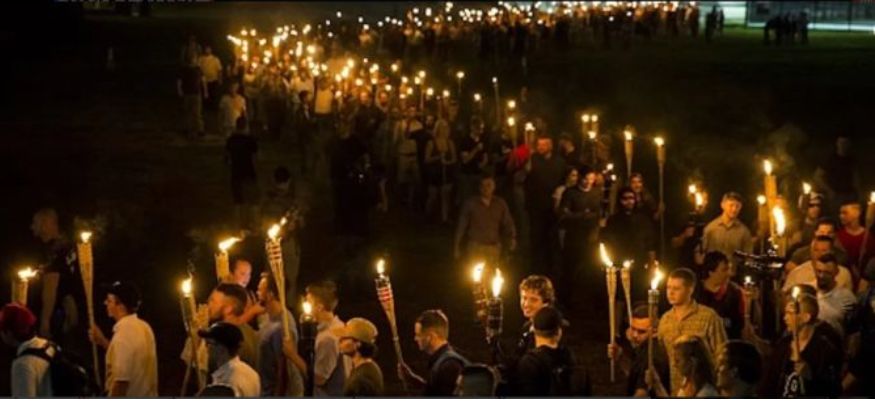
However throughout,
Spencer increasingly became associated with white nationalist websites and
groups, including Andrew Anglin's Daily Stormer, Brad Griffin's Occidental Dissent, and
Matthew Heimbach's Traditionalist Worker Party. In 2015 it attracted broader public attention, particularly
through coverage on Steve Bannon's Breitbart News, due to the above-noted
support for Donald Trump's 2016 presidential campaign, he was
interviewed on CNN.
The extreme right in East and West
More than other political
cultures, the culture of the extreme right is a highly segmented ecosystem of
groups or factions, movements, blogs, websites, and publishers and magazines
that simultaneously collaborate and compete. Far-right groups tend to overstate
their numbers, influence, and connections to position themselves as part of a
structured international movement. Moreover, their networks are difficult to
analyze open sources may be lacking. Discussions may be underground. Rumors can
spread from one source to the other without reliable documentation. Personal
friendships can be more important than ideological commitments. Additionally,
identifying a connection between two movements does not necessarily reveal any
direction of influence. Ideological stimuli are more often a matter of
cross-pollination than a unidirectional dynamic.
Contacts between
far-right movements in Europe and Russia existed before the 1917 Bolshevik
Revolution, even though they were rare because the Russian groups were strongly
anti-Western and insisted on Russia’s distinct path (Sondenveg).
However, the same ideologies were circulating in both the European and Eurasian
spaces; this can be seen on the byways of the Protocols
of the Elders of Zion, which provided the doctrinal foundation for many
anti-Semitic movements. And more recently, those whose ultranationalist
rhetoric mirrors Dugin’s own call for genocide the Ukrainian, echoing Nazi
ambitions against Europe’s Jews.
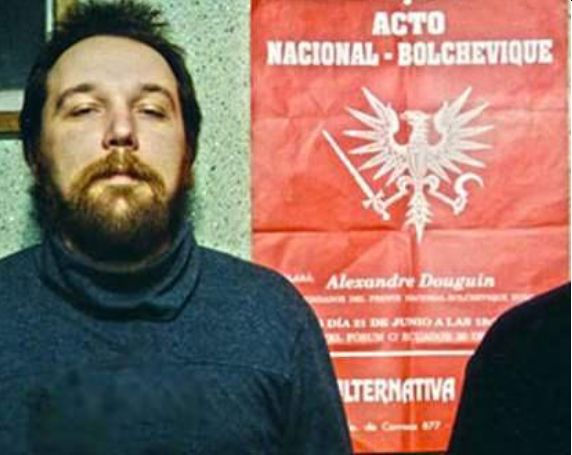
To this belonged the
Kremlin-backed annual Foros Forum convenes in Crimea,
a majority ethnic Russian region in Ukraine, and aims to "shape a new
generation of young Russian politicians," according to one of the
organizers Duma deputy Sergei Markov. A selection of young activists from
Kremlin-created youth groups like Nashi and the Youth Guards join the leaders
and activists of Ukrainian pro-Russian movements to listen to lectures by the
likes of Aleksandr
Dugin, a leading light of the Eurasia movement, which preaches a
Russian-led power block as an alternative to the West. "People gather to
support our fraternal Ukrainian nation, which is groaning under the pressure of
NATO," says Gennady Basov, leader of the nationalist Russian Bloc Party, a
pro-Moscow pressure group based in Crimea.
There was also an
emotional defense of the Kremlin’s war in Ukraine. Its authors were descendants
of some of the
most powerful Russian aristocratic families that fled the country after the
Bolshevik Revolution in 1917.
"Knowledge of
the recent past, namely the past of the pre-revolutionary Russia, gives us the
opportunity, and with it the duty, to expose the obvious historical
falsifications that led to the current drama in Ukraine.” Titled “Solidarity
with Russia,” the letter went on to criticize Western “aggressive hostility”
toward Moscow: “Russia is accused of crimes, without a priori evidence it is
declared guilty.” The authors said that they could no longer accept the “daily
slander against modern Russia … its leadership and its president,” who, they
write, subjected to sanctions and dragged in the dirt against elementary common
sense.
The letter was penned
by Prince Dmitry Shakhovskoi, a well-respected Slavic
scholar who lives in France. His wife, Tamara, was signed by more than 100
princes, counts, and others whose names ranked among the most storied tsarist
Russia, Tolstoy, Pushkin, Sheremetev. These families
maintain a tight-knit community across Europe sustained by galas and black-tie
reunions.
Contradictory as it
may seem, however, support for the Kremlin among White émigrés and their
descendants is hardly new. It goes back almost to the revolution when the new
Bolshevik secret police first began actively recruiting Russians living in
Europe. Some believe that Shakhovskoi’s letter
represents the Kremlin’s latest attempt to exploit the émigré community. And,
in that, it sheds light on what exactly Russian President Vladimir Putin is
trying to accomplish with his new Cold War with the West.
Collaboration between
the White émigrés and the Kremlin goes back to the 1920s. The Bolshevik secret
police began actively recruiting members of the so-called first wave of émigrés
soon after settling abroad. Other sympathizers changed their minds about the
Communists after World War II when many believed Stalin saved the motherland
from the Nazis. Deceived about his rule, many émigrés returned to the USSR only
to be sent to the gulag.
Over the following
decades, other émigrés and their children and grandchildren settled across
Europe, the United States, and elsewhere assimilated into Western society.
However, many maintained informal ties to the USSR, attending Soviet embassy
receptions and Kremlin-organized cultural events and traveling to the Soviet
Union.
Although White émigré
descendants’ formal relations with Russia’s new authorities warmed after the
Communist collapse in 1991, they remained brittle, as some exiled families
tried in vain to reclaim former property.
A young billionaire
named Konstantin
Malofeev is also believed to provide an important conduit to the White
émigré community. The founder of an investment firm named Marshall Capital
Partners, who calls himself an “Orthodox businessman,” has been the subject of
at least two criminal investigations into theft from state-controlled banks.
However, the probes were dropped around the time he’s believed to have begun
playing a central role in financing and directing the separatist rebellion in
eastern Ukraine, which Moscow has fueled with arms, troops. The whipping up of
propaganda espousing a radical Russian
Orthodox-based nationalism. Novaya Gazeta, one of Russia’s few remaining
independent newspapers, reported that Malofeev was behind a memo to the Kremlin
proposing the
annexation of Crimea and part of eastern Ukraine even before the country’s
old pro-Moscow government had collapsed. He is also close to the head of the
Russian Orthodox Church, Patriarch Kirill, who helped draft a new law for
censoring the Internet.
Malofeev’s
connections to the émigré descendants include, according to Kirilenko and
others, a close friendship with Shakhovskoi’s son,
who works in Moscow and is married to the daughter of Zurab Chavchavadze, a
Georgian prince who is one of the representatives of a wing of the Romanov
family in Russia. Malofeev also heads foundations that advocate Russian
Orthodox values and funds a private Orthodox school of which Chavchavadze is
the director. Although Malofeev’s star in the Kremlin is believed to have waned
since last year, it’s clear he remains one of a small group of like-minded
insiders who carry out useful
roles for the Kremlin.
Viktor Moskvin, the
director of another state-funded cultural group in Moscow called the Alexander
Solzhenitsyn House
of Russia Abroad, said it was his idea to approach Russian media about
publicizing the letter after Shakhovskoi told him
about it during a White army celebration in Paris. His group, which is chaired
by the widow of the famous dissident writer and strong Putin supporter and was
founded to collect an archive of émigré documents and relics, also provides a
direct conduit for Moscow’s ties to Russian émigrés. Moskvin insisted that Shakhovskoi’s letter is important because its signatories
represent the cream of Russia’s historical elite. “They are representatives of
the oldest and most illustrious Russian families, who played a huge role in the
Motherland’s history,” he told the government’s official paper of record, Rossiiskaya Gazeta. “Today, they include professors of
leading universities, scholars, doctors, successful entrepreneurs, and
journalists. They support Russia and the Russian people with their souls.”
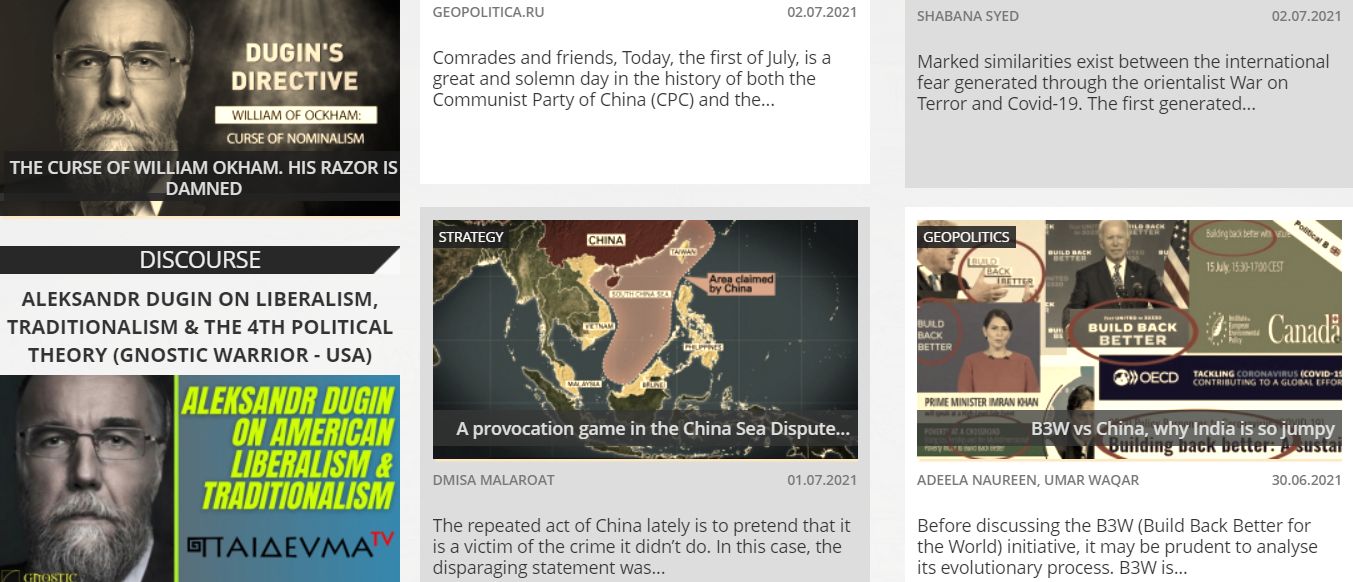
Cooperation with European extreme right-wing parties
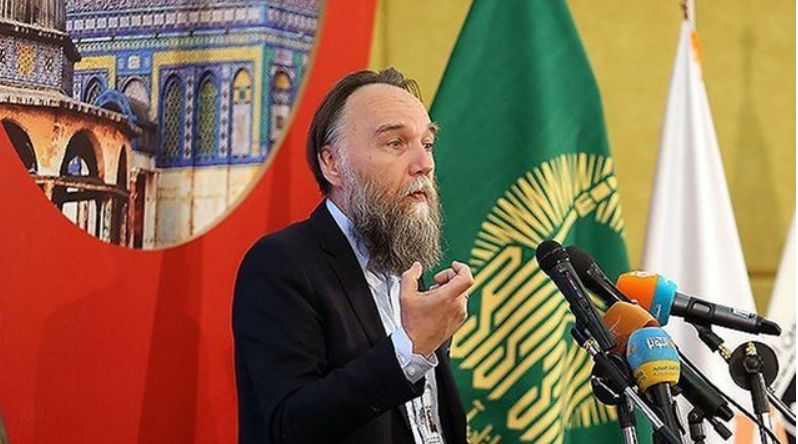
Putin isn’t aiming to
galvanize the support of only émigrés. The many hundreds of social media
comments supporting Shakhovskoi’s letter included
French and other Europeans who said they were swayed by the idea that the
writers had special authority to understand the Kremlin’s actions. “I find here
a taste of Free France, where the monarchists rubbed anarchists,” read a
comment on a French translation of the letter.
Moscow is encouraging
such sympathies among both far-left and far-right groups to help split Western
opinion. That’s an old game for Moscow: European Communist parties and other
groups acted the same way during the Cold War. Now the Kremlin is quietly cultivating
radical parties across the continent, including some openly neofascist, united
by the common goal of undermining the European Union.
Despite the paradox,
many far-right parties across Europe, including France’s anti-immigrant
National Front and the Dutch Freedom Party, are voicing loud support for Putin.
Russia also has ties with Hungary’s nationalist Jobbik party, Slovakia’s
People’s Party, and Bulgaria’s anti-EU Attack movement. National Front leader
Marine Le Pen recently praised Putin, saying that “he proposes a patriotic
economic model radically different than what the Americans are imposing on us.”
Her party went to take out a loan worth more than $10 million from a Russian
bank owned by a Kremlin ally. Last year, both the National Front and the United
Kingdom’s anti-EU UK Independence Party won 24 seats in the European
Parliament, an institution they want to sideline.
Kremlin allies and
insiders have been busy hosting conferences to rally support groups in Serbia,
Switzerland, and elsewhere. Yakunin, the billionaire who organized the
Tunisia-Sevastopol cruise for a new generation of White Russians, is co-chair
of an organization called the Franco-Russian Dialogue Association. Putin and
former French President Jacques Chirac set up in 2004 ostensibly to improve
economic and cultural links. Last summer, at the group’s annual assembly, held
at the Russian embassy in Paris, Yakunin railed against Washington for inciting
European countries to enact new sanctions.
In Austria last May,
Konstantin Malofeev organized a meeting of European right-wing politicians.
Alexander Dugin headlined the event. With members of the National Front and
Austria’s Freedom Party in attendance, “it looked like a congress of
anti-European forces,” Kirilenko says. “They paint themselves as supporters of
traditional values that are under attack in the West to mobilize public opinion
that Russia is the genuine home of spirituality.”
Contacts between
far-right movements in Europe and Russia existed before the 1917 Bolshevik
Revolution, even though they were rare because the Russian groups were strongly
anti-Western and insisted on Russia’s distinct path (Sondenveg).
However, the same ideologies were circulating in both the European and Eurasian
spaces, particularly the infamous Protocols of the Elders of Zion, which
provided the doctrinal foundation for many anti-Semitic movements.
While the political
relevance of right-wing populist challenges to liberal democracy is widely
recognized, the theoretical bases of right-wing populism are rarely the targets
of sustained analysis. Yet what Alberto Spektorowski
writes about the New Right perhaps applies also to right-wing populisms more
generally: their importance “lies . . . in [their] theoretical innovation.”2
Despite these
attempts to “excuse” fascism from its racist elements, Dugin is certainly not
indifferent to racial theories.
Like Julius Evola,
one of his main sources of inspiration, he believes in spiritual races that
separate peoples into two major categories: subject races and object races. It
goes without saying that the choice of terminology, subject and object,
borrowed from twentieth-century philosophy, is a way of implying superiority
and inferiority without the consequent legal condemnation.
The third line of
argument anchors fascism into a discursive framework, nationalism, that enjoys
more positive connotations in some parts of Russian public opinion. To do this,
Dugin plays with words and blurs terms to make them interchangeable. According
to him, the concept of National Socialism sounds negative, even though the two
words that comprise it are positive. Therefore National Socialism should be
understood as no more than “German socialism” because fascism is a proletarian
regime “whose central figures are the peasant, worker, and soldier.”
The Franco regime,
for instance, would not qualify as fascist because it promoted a “national
capitalism” that is actually the enemy of authentic fascism. Similarly,
“Russian Fascism can be described as Russian socialism.” At the same time,
Marxism-Leninism was lost in a sterile doctrinal rigidity, according to Dugin.
Russian National
Socialism would be “more peasant than the
proletariat, more communitarian and cooperative than statist, more regional
than centralized. From Dugin’s perspective, fascism would thus be no more than
a “leftist nationalism.”
Dugin deploys the
words “nationalism” and “fascism” interchangeably. He starts his article
“Leftist Nationalism” by stating, “The twentieth century knows only three forms
of ideology: liberalism, communism, and nationalism.’ In “Fascism without
Borders and Red,” he included a very similar sentence but replaced nationalism
with fascism. He proclaimed that “Russia [had] passed two ideological moments,
the communist and the liberal. . . . Fascism is the remaining one.”
However, to develop a
more solid narrative that would make fascism adequate to Russian political
traditions. Dugin has gone further. He has invested himself in revamping the
German Conservative Revolution tradition to foster fascism's reintegration into
the “politically correct” realm by rebuilding its intellectual genealogy.
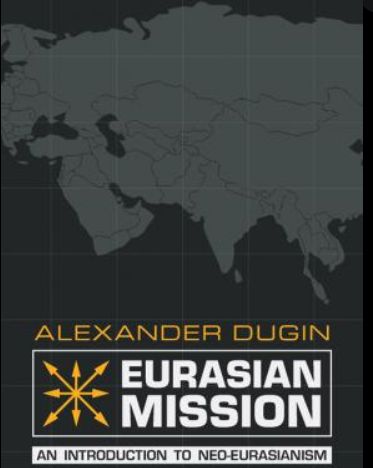
Offshoots and further sources

The Eurasian Movement
has an offshoot, the Global Revolutionary Alliance (GRA). Its manifesto,
dated April 1, 2017, espouses an apocalyptic vision that humanity is at the
verge of an end to “capitalism, resources, society, nations, peoples,
knowledge, progress.” The GRA downplays the significance of wider social
transformations and places the blame for these processes, rather
conveniently, on the “global Western-centric world” and “the ruling class
of globalism.”
The GRA calls for a
global revolution: “liberalism … must be destroyed, crushed, overthrown,
obsolete.” It brands the United States as the “country of absolute evil,”
vowing to partner with any anti-US, anti-Western, anti-NATO, and anti-liberal
countries in their revolution. At its core, the GRA manifesto synthesizes
conspiracy theories about a “deep state,” globalization, mutants, cyborgs, the
sinister meaning of the Statue of Liberty, and so on. What is unsettling is
that the manifesto does not read at all like a conspiracy theory. Instead, it
is framed as reality, aiming to unite people worldwide to safeguard their
“normal” way of life in collectives and railing against the freeing
individualization and “atomization” of the West. At the foundation of the GRA
ideology is so-called neo-Eurasianism. As Dugin
explains, triumphant liberalism moved out of the political realm to
metamorphose into “biopolitics,” absorbing flesh and blood to become a
lifestyle. He asserts the need for an ideology to defeat neoliberalism. If it
is not defeated, the only remaining option is a “dissolution” into triumphant
liberalism, its lifestyle, and its global world. Dugin offers a solution that
he believes is powerful enough to strike down neoliberalism and its lifestyle.
This is where neo-Eurasianism strikes, offering what Dugin sells as a
complete package: a cause, an ideology, and a strategy for a revolution to
reclaim one’s identity and tradition. In essence, Dugin proposes “an alternative model of a conservative future.”
Neo-Eurasianism includes such conflicting notions of
“fundamental conservatism (traditionalism), social-conservatism and
conservative revolution.” Such palingenesis in Dugin’s ideas intertwines with
the as seen above ideas of Julius Evola, an Italian fascist traditionalist, who venerated
traditional society and considered modernity as corruption.
Dugin systematically
refers to the main representatives of this Conservative Revolution: the Jungkonservativen, with Arthur Moeller van der Brack,
Oswald Spengler, Carl Schmitt, Othmar Spann, and Wilhelm Stapel; the National
Revolutionaries, mostly Ernst Jiinger and Franz
Schauwecker; and the German National Bolsheviks around Heinrich Laufenberg and
Ernst Niekisch. Dugin points out the tensions between
these movements and Hitlerism and emphasizes several contradictory points:
Hitlerism was further to the right than the Conservative Revolution, Hitler was
a Russophobe. In contrast, the others were Russophile, and Hitler was a racist
while the others were non-xenophobic nationalists.
To rehabilitate
fascism, Dugin thus needs to dissociate the Nazi regime from the Conservative
Revolution. However, he largely fails at convincingly articulating this crucial
distinction. For example, lie affirms that “Fascism is the Third Way,”!] that
“the most complete and total (although also quite orthodox) incarnation of the
Third Way was German National Socialism,” and that “National Socialism
undoubtedly took and realized the impulsion coming from the conservative
revolutionary ideology. In this usage, the three terms, Nazism, Fascism, and Conservative Revolution,
largely overlap, and Dugin's demonstration of their differences and
contradictions fails to be conclusive. Last but not least, although Dugin seeks
to promote fascism that diverges from Nazism, his major philosophical
references have all directly inspired the Nazi regime: Julius Evola, Carl
Schmitt, and Martin Heidegger.
In an interview in
2014, Dugin definitively renounced what he calls the second and third political
theories (communism and nationalism/fascism, the first one being liberalism)
and stated that the fourth proposes a full break with the first three because it
no longer seeks to accommodate modernity, but instead denies it in its
entirety. Whereas in the early 1990s, he claimed that Russia had tested
liberalism and communism and had to turn to a third choice,
fascism/nationalism, twenty years later, he proclaimed, “Liberalism, communism,
and fascism, ideologies of the twentieth century, are finished. That is why it
is necessary to create a new, fourth political theory.
But despite pedantic
declarations of novelty, Dugin had merely rearranged the doctrines in which he
has always believed. He states that of all forms of conservatism, the most
interesting is that of the Conservative Revolution, which he defines by repeating
the formula of Arthur Moeller van den Bruck, “Conservatives who have preceded
us have sought to stop the revolution, we must take the lead of it.”
National Bolshevism
and Eurasianism are the two ideologies that are
closest to the fourth political theory. Dugin himself, therefore, offers the
keys necessary to decipher the falsification of his “novelty.” He recognizes
that the drama of the fourth political theory is "that it was hidden
behind the third (Nazism and fascism). Its tragedy is to have been overshadowed
historically by the third, and being allied with it, given the impossibility to
conduct an ideological war on three fronts (against liberalism, communism, and
fascism/Nazism). Nothing thus changed, except the window dressing, and Dugin
today, as twenty-five years ago, continues to give voice to what fascism is a
la Russe.
Ideologically. Eurasianism is the Russian version of the European
far-right. The founding fathers of Eurasianism,
living as emigres in European capitals in the 1920s and 1930s, were impressed
and inspired by the German Conservative Revolution and its combination of
“nationalism" and “conservatism." They associated its main thesis,
the need for a Third Way between capitalism and communism, with a belief in
Russia as the Third Continent between Europe and Asia. While they renounced
Nazism, which they regard as pure racism, they followed very closely Italian
fascism, in which they saw the inspiration for a future Eurasian Russia. Today,
Alexander Dugin, the main ideologue of neo-Eurasianism
since the collapse of the Soviet Union, has played a key role in mediating
far-right theories in Russia. His definition of Eurasianism
entirely overlaps with the Conservative Revolution a la Russe. Yet, contrary to
the founding fathers of Eurasianism, Dugin borrows
from the whole spectrum of far-right doctrines and does not limit himself to
the Third Way theories. So-called Esoteric Nazism directly inspires him, and
his metaphorical language calls indeed for violence. He also borrows from some
of the New Right theories. He thus offers a complex doctrinal spectrum that is
always in intimate dialogue with movements coming from Western Europe.
Eurasianism in Russia and the far-right in Europe share more than
doctrinal principles inspired by fascist traditions. Their beliefs push them to
interpret the international order with similar toolkits. In both cases, the
enemy is identified as the United States (both a country and a civilization)
and liberalism (both political and moral, and sometimes, but not always,
economic) as its ideological backbone. In their worldview, resistance to this
international order can emerge only from countries or regions where
anti-Enlightenment values are well preserved and cherished. Europe should be
one of them. This statement is aspirational: the Europe they dream of does not
exist. On the contrary, both Eurasianism and the
far-right complain about the construction of the European Union, which is
viewed as a bureaucratic, dehumanized machine that serves U.S, interests and
liberal values, the accepted or implied objectives of which are the destruction
of authentic European values and the underlying identity of the continent.
Today neo-Eurasianism holds the view that Europe’s real nature is to
ally with Eurasia to form the Heartland, a continental mass able to resist
maritime powers such as the United States, its subordinate, the United Kingdom,
and their allies on other continents, thanks to an extreme ideology directly
inspired by fascism. Thus neo-Eurasianism is not
anti-European, but instead anti-Western, anti-Transatlantic, and anti-liberal,
and it believes in the common destiny of European and Eurasian peoples.
A majority of the
European far-right shares this vision of a united continent. Their enemies are
the same, especially the European Union, as are their hopes for a pan-European
future for “white” or “Christian” peoples in which Russia would have a role. This
is not only a result of recent evolutions linked to European construction. Many
of the Conservative Revolution theoreticians of the 1920s and 1930s were
impressed by the messianic forces unleashed by the Bolshevik Revolution and
sought a strategic partnership with a phoenix-like Russia. During World War II,
the Nazi regime and its allies searched for a pan-European idea that would
catalyze nationalist energies toward a common goal without triggering
fratricidal conflicts. Fascist groups revived and
updated this idea in the 1960s, as they sought to abandon Nazi ideology on
German exceptionalism in favor of a pan-European phenomenon. Their movement.
Young Europe (YE) was named after the 1942 Third Reich journal of the same
name. One of YE‘s main ideologists. Jean-Franco is Thiriart,
who served in the Waffen-SS and defended collaboration with the Nazi regime,
advanced the slogan of a Europe "from Reykjavik to Vladivostok,” thus
inviting Soviet Russia to join this new political construction. In the 1980s, Thiriart reaffirmed his pledge: “If Moscow wants to make
Europe European, I preach total collaboration with the Soviet enterprise. I
will then be the first to put a red star on my cap, Soviet Europe, yes, without
reservations.”
This shared
aspiration of what Europe’s future should be, unified, detached from the
trans-Atlantic world, and turned toward its continental neighbor, Russia, also
provides a common ground for the current honeymoon between European far-right
parties and Vladimir Putin’s Russia. But the toolkit for analyzing this agenda
is far more complex than the one needed to comprehend the contacts between
Dugin's neo-Eurasianism and his far-right
counterparts in Europe. Contrary to frequent media statements, Dugin’s theories
are not the direct inspiration for Putin's regime and its quest for great
powers. The Kremlin has not made official any new state ideology inspired by
the Conservative Revolution, even if it borrows some themes. However, in
Europe, the Kremlin has recently acquired more or less the same allies that
Dugin has cultivated for more than two decades. As seen from the Kremlin, those
who denounce Brussels’ technocrats and their submission to U.S. interests are
potential friends of Russia. In addition to this geopolitical orientation, the
European far-right shares with the Russian regime a similar anti-liberal
narrative that denounces economic and political modernity, individualism, the
destruction of so-called traditional values, and the imposition of external
cultural standards.
But although Dugin
and the European far-right belong to the same ideological world and can be seen
as twins, the alliance between Putin’s regime and the European far-right is
more a marriage of convenience than one of true love.
This brief sketch
outlines how Eurasianism in Russia and the far-right
in Europe share many beliefs, principles, and common geopolitical aims. This
volume aims at untangling this puzzle by tracing the ideological origins and
individual paths that have materialized in their permanent dialogue. The
historical roots of this exchange have only been partially studied. The mutual
influence between the founding fathers of Eurasianism
and the German Conservative Revolution remains largely unexplored, as do the
poorly understood relations between postwar far-right movements and the Soviet
Union. This volume focuses on the contemporary situation, with regular
references to history, to provide the keys to analyze s in Europe.

Julius Evola
Evola’s work has
recently seen a transnational renaissance. It has influenced the alt-right
movement in the US, the Greek neo-Nazi Golden Dawn party, and the Hungarian
nationalist Jobbik party. Steve Bannon, Donald Trump’s former chief adviser, is
also attracted by Evola’s traditionalist and anti-modernist philosophy, his
anti-liberal aristocratic elitism, his spiritual racism, and his male-dominated
worldview. These groups and individuals use Evola’s work to call for a
Christian-dominated Western world that must be defended against all immigrants,
Muslims in particular. Such calls ignore the fact that Evola was highly
critical of Christianity and regarded Islam as the more
spiritually advanced and thus more traditional religion, a classic example
of cherry-picking during Evola’s initial adoption by Italy’s far-right 1970s.
Nevertheless, Evola’s growing popularity among the radical right today calls
for a deeper understanding of his teachings and philosophy to better understand
the present transnational right-wing extremist and terrorist scenes.
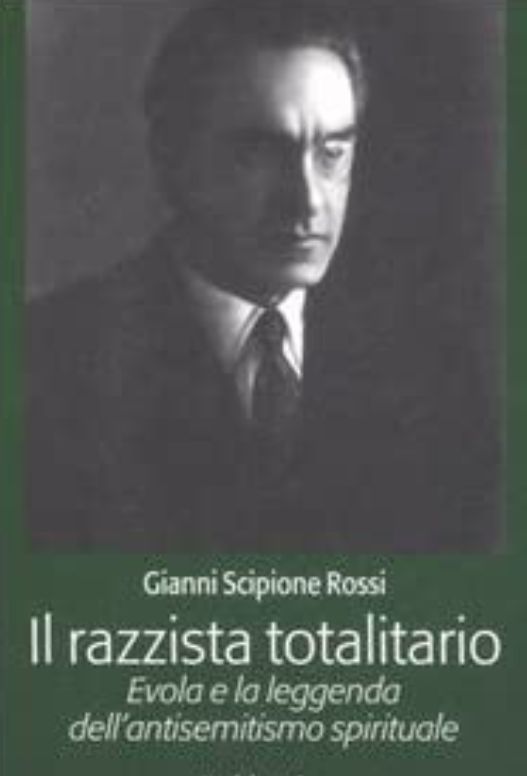
Even though his
heterodox ideas were not always well received by the Italian ruling class of
the time. They earned him the suspension of some publications by the PNF and
Germany's suspicion of the Nazi hierarchies.3 Evola contributes to the dissemination
in Italy of important European authors of the nineteenth and twentieth
centuries: Bachofen, Guénon, Jünger, Ortega y Gasset, Spengler, Weininger, translating some of their
works and publishing critical essays. The complexity of his thought gave him,
even after the end of the war, a large following in the Italian and European
conservative circles, from the most radical ones of neo-fascism (Franco Freda,
Pino Rauti, and Enzo Erra of the New Order Studies
Center) to those represented by members of the more moderate right (Giano Accame, Marcello Veneziani).
Evola was also considered one of the main ideologues of the terrorist far right
during the Years of Lead 4 and his works are also appreciated by some fringes
of Islamic fundamentalism 5 Evola is also a popular author, largely due to his
metaphysical, magical, and supernatural beliefs, including belief in ghosts,
telepathy, and alchemy. His works are translated and published in Germany,
France, Spain, Portugal, Belgium, Greece, Switzerland, Great Britain, Russia,
United States, Mexico, Canada, Romania, Argentina, Brazil, Hungary, Poland,
Turkey.6
When Evola’s ideas
are undergoing a revival, topics like these take on more than academic
significance.7 The entwinement of biological and spiritual beliefs about race
is not a thing of the past, no minor concern in light of the porous boundary
between putatively extremist ideologies and the cultural mainstream.8 Evola’s
project may have failed in its era. Still, the resentments that animated it has
by no means disappeared. Critical scholarship on allegedly ancient racial myths
and their modern implementation can help clarify our understanding of a history
that has lost little of its relevance. Opaque as they may seem to contemporary
observers, Evola's theories espoused in a fateful interchange between Nazi
Germany and Fascist Italy deserve renewed attention today.
Enter Steve Bannon
In an article
titled "how
a mystical doctrine is reshaping the right" Steve
Bannon, Russia’s Alexander Dugin, and Brazil’s Olavo de Carvalho are
united by their affinity with a spiritual movement that fundamentally rejects
modernity.
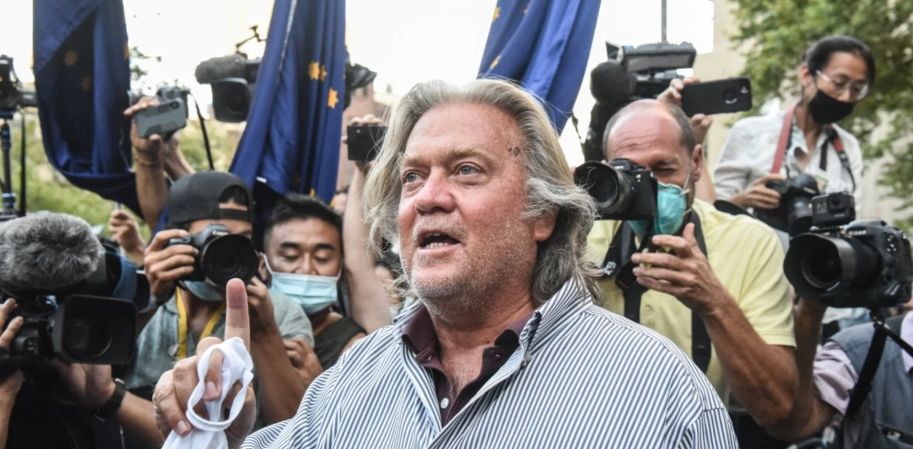
The same as also in
Austria and other countries worldwide Alexander Dugin met
with members of the National Front and Austria’s Freedom Party.
Near the end of this
investigation, I also was able to read the book by Benjamin R. Teitelbaum
of which the Sept/Oct 2021 issues of Foreign Affairs reports that: Seeking
to understand the roots of Bannon’s eccentric post-fascist beliefs, Teitelbaum
(a music professor who also studies radical populists) convinced him to sit for
20 hours of interviews. Teitelbaum sets out to find the leaders of Bannon’s
underground “spiritual school” committed to “Traditionalism,” a secretive
ideology that rejects modernity, the Enlightenment, materialism, and
globalization. They include a bearded supporter of Russian President Vladimir
Putin who promotes “Eurasianism” as an alternative to
the rotten West, the former leader of a Hungarian nationalist and anti-Roma
party, an Iranian American author peddling plans for a eugenic purification of
Persians, a Brazilian philosopher active on social media and close to Brazil’s
current populist government, and a Briton with obscure corporate and political
connections and the code name “Jellyfish.
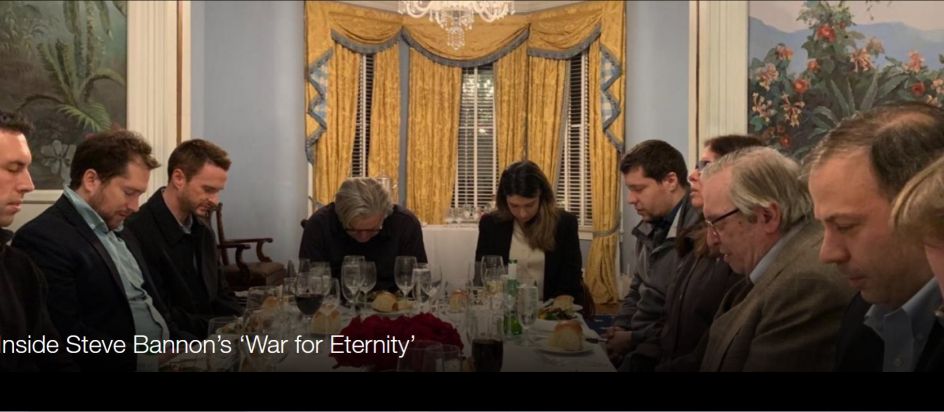
Teitelbaum, who
kept an exact diary of all of his meetings with Bannon inclusive pictures taken
with both him and Bannon on
it, focuses particularly on the year 2018. He also describes
going to a bookstore with Bannon where the latter bought a copy of H.P.
Blavatsky's Occult primer "The Secret Doctrine," a book we have
actually already had extensively covered in our extensive
archive of older articles here.
Teitelbaum also
mentioned that 'Steve told me, he connected with University of San
Francisco philosophy professor Jacob Needleman: a scholar knowledgeable,
as Teitelbaum mentions, of Rene Guenon. It is
widely known that Dugin’s worldview fuses a revived pan-Slavism (the
ideology that helped trigger Europe’s fratricidal explosion in 1914) with more
cosmopolitan fascist currents, particularly the so-called Traditionalism of
René Guénon and Julius Evola. In
fact, Guénon’s main disciple was indeed
Julius Evola the leading inspirator for Dugin's Eurasianism, which
various news sources mentioned was cited by Bannon including the NYT with Steve
Bannon Cited Italian Thinker Who Inspired Fascists.
War for
Eternity joins the dots between this newly influential philosophy and
leading personalities from the global right. In 2018-9 Teitelbaum spent 20
hours talking to Bannon. He spoke to Dugin and met with Olavo de
Carvalho, a one-time
journalist and astrologer who advises Brazil’s president Jair Bolsonaro.
Dugin and his many
accolades to which according to the well-researched book
by Teitelbaum, thus attempt to pursue a multiform strategy on the
fringe of the classical electoral political spectrum. He develops a
geopolitical discourse aimed at a large public, a concept of Eurasia as the
basis for a new ideology of Russian great power for the Putin establishment,
and Traditionalism and other philosophical and religious doctrines restricted
to small but influential and consciously elitist intellectual circles.
As we have seen
above, the simplest way into Traditionalism is to think of it as the fourth
quadrant on a political compass where the other three are fascism, liberalism,
and communism. Traditionalism rejects all three rivals on the same grounds that
they are modernist, they’re competing for the chance to modernize the world;
and they’re materialist: communism and liberalism are both obsessed with money,
fascism with bodies.
And though Teitelbaum
begins and ends with Bannon and Dugin, we can see this hunger for the end of
the world far beyond the bounds of his book, in the spiritualized contrarianism
of Peter Thiel; in the neo-reactionary movement, which calls for the end of
democracy; and in the watered-down religious traditionalism of pop gurus such
as Jordan Peterson, whose dragon-slaying rhetoric and imagery hearken back to a
mythic, imagined time of heroes and demigods: primal figures free of the
atrophy of modern urban society.
US President Donald
Trump (L) congratulates Senior Counselor to President Stephen Bannon during the
swearing-in of senior staff in the East Room of the White House on January
22, 2017, in Washington, DC:
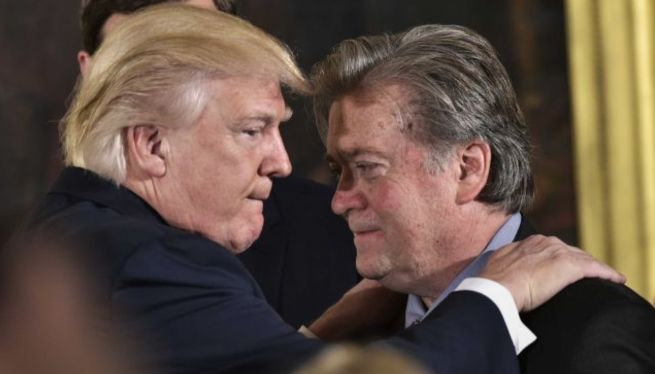
The drama of War
for Eternity culminates in the meeting of Bannon and Dugin in Rome only a
few blocks from Evola’s former apartment, where Bannon solicits the Russian’s
opinions of Heidegger before attempting to persuade him to join some united
global Traditionalist front. “We were born into nothingness, Mr. Bannon,” the
Russian reflects. “And yet we each found our way to it,” Bannon responds. “The
Tradition.”
In the end,
however, Teitelbaum's book is good on Bannon but weak on Dugin's wider
background including missing is Russian history and its relevant political
inclinations during the various time periods we instead have detailed in the
above earlier part of this by now extensive investigation.
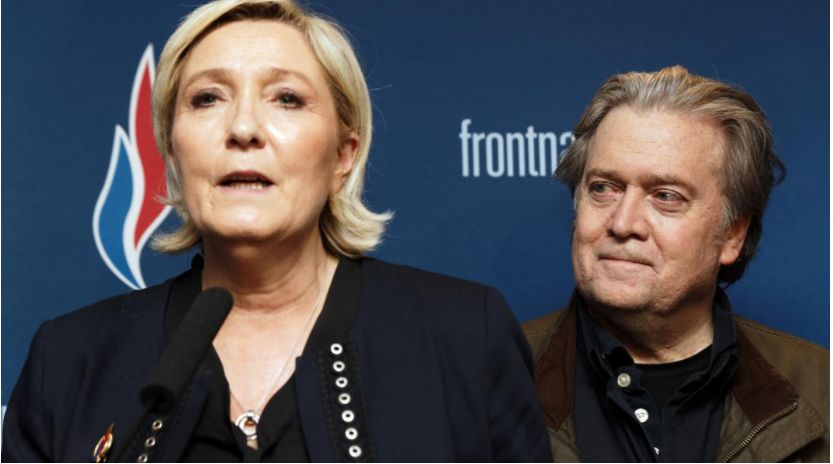
In his recent
book The Decadent Society, Ross Douthat identifies the fundamental problem
of our age not as libertinage but as disaffection: Ours is a world in which the
political landscape has been reduced to “a kind of digital-age playacting in
which young people dissatisfied with decadence pretend to be Fascist and
Marxist on the Internet, reenacting the 1930s and 1960s with fewer street
fights and more memes.” If this is so, then the Duggins and the Bannons of the world are the biggest play-actors of all:
reenacting the twilight of the gods, just with more memes.
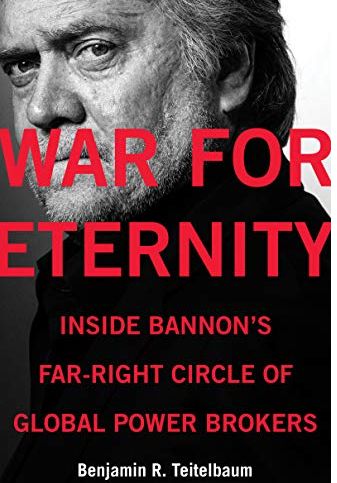
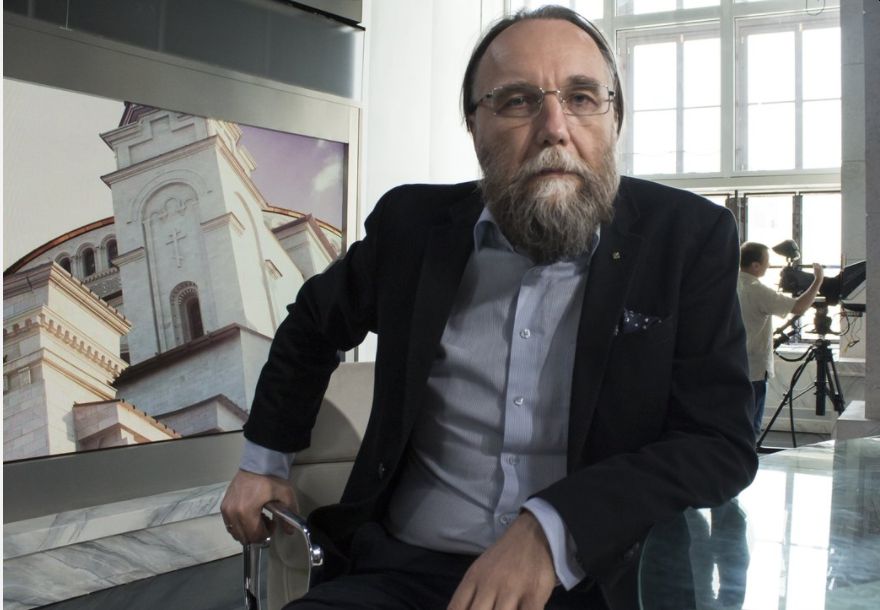
Even
if Dugin’s institutional presence in Russia and all the countries we
mentioned, including the USA, is based on groupuscules, the influence of his
personality and his works must not be underestimated. Despite his rhetorical
radicalism, which few people are prepared to follow in all its philosophical
and political consequences, Dugin has become one of the most
fashionable thinkers of the day. Using networks that are difficult to trace, he
disseminates the myth of Russian great power, accompanied by imperialist,
racialist, Aryans, and occultist beliefs expressed euphemistically
and whose scope remains unclear, but that cannot remain without
consequences. Dugin’s role as an ideological mediator will probably
be an important point to consider in any long-term historical assessment: he is
one of the few thinkers to engage in a profound renewal of Russian nationalist
doctrines, repetitive in their Slavophilism and their czarist and/or Soviet
nostalgia. His originality lies precisely in his attempt to create a revolutionary
nationalism refreshed by the achievements of 20th-century Western thought,
fully accepting the political role these ideas played between the two world
wars. Therefore, in his opposition to American
globalization, Dugin unintentionally contributes to the
internationalization of identity discourse and the uniformization of those
theories attempting to resist globalization. He illustrates that, although
aiming for universality, these doctrines are still largely elaborated in the
West. This is a paradoxical destiny for a Russian nationalist,
whose self-defined and conscious “mission” is to anchor a profoundly
Western intellectual heritage in Russia and to use it to enrich his fellow
citizens.
And not to mention
that he is a charmer Russian President Vladimir Putin danced arm-in-arm
with Austria's foreign minister, Karin Kneissl:
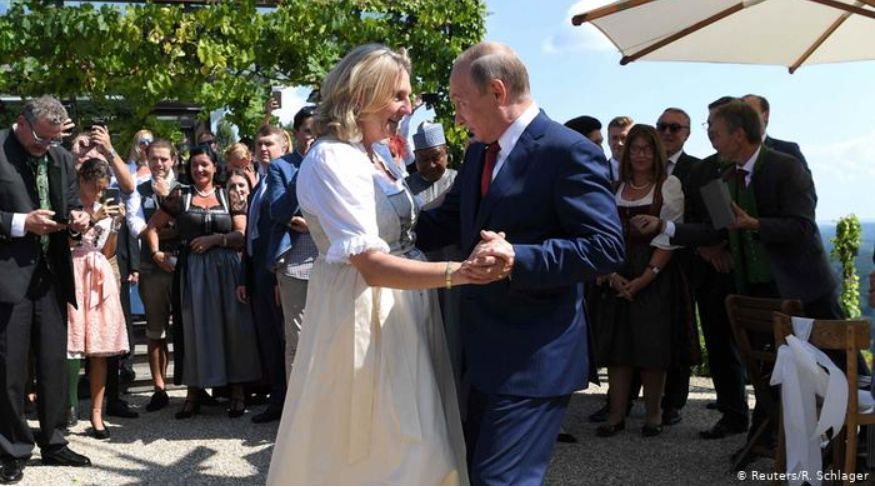
Germany ueber alles?

One must note the
paradoxical absence of Germany. While German thought from the early twentieth
century and the interwar years comprises one of the core tenets of Dugin’s
doctrine, he has few allies in Germany, compared with his deep interactions
with the Francophone world and the Mediterranean. His German acquaintances have
only very recently been cultivated, namely with the journal Zuerst,
launched in 2010 as the successor of the neo-Nazi Nation and Europa to promote
right-wing thought in Germany. Zuerst! prominent
journalist Manuel Ochsenreiter, has interviewed Dugin
several times. Thanks to this network, Dugin was invited to join the March 2015
conference of far-right thinkers and activists organized by Dietmar Munier, who
owns the two biggest far-right publishing houses in Germany, Arndt and Lesen and Schenken, Although
Dugin has read and sometimes cited Armin Mohler, a disciple of Ernst Junger and
Swiss-born far-right political writer and philosopher, known for his works on
the Conservative Revolution and associated with the Neue
Rechte, the two men do not appear to have met.
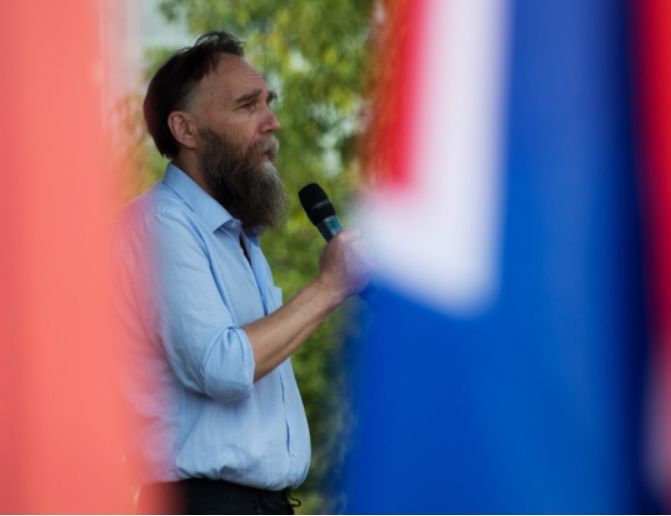
But France Yes
Back in 2011, Marine
Le Pen acknowledged admiring the Russian president and supporting Russia:
‘"I can only be concerned when I see that our president [then Nicolas
Sarkozy], at the instigation of the Americans, is turning his back on Russia.
Following the Americans, the French media demonizes Russia.'] The FN insists on
several positive components of the Russian regime: authoritarianism (the cult
of the strong man), anti-American jockeying (the fight against U.S. unipolarity
and NATO domination), defense of Christian values, rejection of gay marriage,
criticism of the European Union, and support for a “Europe of Nations.” With
Russia's international condemnation after the Ukrainian crisis, Marine Le Pen
has turned out even greater praise: “Mr. Putin is a patriot. He is attached to
the sovereignty of his people. He is aware that we defend common values. These
are the values of European civilization. ”[] She, therefore, calls for an
“advanced strategic alliance” with Russia, which should be embodied in a continental
European axis running from Paris to Berlin to Moscow. Regarding the Ukrainian
crisis, the FN totally subscribes to the Russian interpretation of events and
has given very vocal support to Moscow's position. The party criticized the
Euro-Maidan revolution, thinks that the EU “threw oil on the fire” by proposing
an economic partnership with a country in which half the population looks to
the East, states its preference for a federalization of Ukraine that would give
a broad autonomy to the Russian-speaking regions, and supports Russian
proposals for solving the Donbas conflict.

The FN has become increasingly
active in its relations with Russia, including several trips by high-ranking
leaders: Marion Marechal-Le Pen, Marine’s niece, and France's youngest MP,
traveled there in December 2012; Bruno Gollnisch,
executive vice president of the FN and president of the European Alliance of
National Movements (AEMN), went in May 2013; and Marine Ee Pen and FN vice
president Louis Aliot both went in June 2013. During
the second trip in April 2014, Marine Le Pen was received at a high political
level by the president of the Duma, Sergei Naryshkin, the head of the Duma’s
Committee on Foreign Affairs, Aleksei Pushkov, and
the deputy prime minister, Dmitri Rogozin.
Several Russophile
figures surround the president of the FN and have enhanced the party’s
orientation toward Russia. The most famous is Aymeric Chauprade.
an FN international advisor and European deputy who is close to Konstantin
Malofeev. Next comes Xavier Moreau, a former student of Saint-Cyr, France’s
foremost military academy, and a former paratrooper, who directs a Moscow-based
consulting company, Sokol, and seems to play a central role in forming
contracts between FN-friendly business circles and their Russian counterparts.
Fabrice Sorlin, head of Dies Irae, a fundamentalist
Catholic movement, leads the France- Europe Russia Alliance (AAFER). The FN
also cultivates relations with Russian emigre circles and institutions
representing Russia in France. The FN’s two MPs, Marion Marechal-Le Pen, and
Gilbert Collard are both members of a France-Russian friendship group. Marine
Le Pen seems to have frequently met in private with the Russian ambassador to
France, Alexander Orlov who chairs the board of Gazprom-Nord Stream. These
alliances weakened during the Ukrainian crisis, given Chancellor Angela
Merkel’s leading role in condemning Russia. But some new friends emerged among
Die Linke, a powerful post-communist party in former East Germany.
In addition to the
political networks, there is a powerful and well-structured net of “civil
society” organizations and think tanks that promote Russian interests. The most
well-known among them is the Institute for Democracy and Cooperation (IDC), led
by Natalia Narochnitskaya, a high priestess of
political Orthodoxy since the 1990s and former member of parliament (MP) in the
Russian Duma. John Laughland, the Eurosceptic British historian and frequent
commentator on the Russian-funded television network RT, is director of studies
at the IDC, which is funded by Russian “charitable NGOs” (non-governmental
organizations). The Russian government makes use of the long-established
cultural institutions associated with the presence of an important Russian
diaspora in France that dates back to the 1920s and the Soviet period. It
contributes to a myriad of Russian associations such as the Dialogue
Franco-Russe, headed by Vladimir Yakunin, who was head of Russian Railways and
a close Putin adviser until August 2015, and Prince Alexandre Troubetzkoy, representative of the Russian emigration.
Paris is also home to the largest Russian Orthodox Church in Europe, which
opened in fall 2016 in the center of Paris. The Moscow Patriarchate’s close
relationship with the Kremlin helps project Russia’s “soft” power in Europe.9
Russia’s Calibrated Tools
Today Russia is
successfully manipulating the asymmetrical soft power tools. It has joined lip
with new allies that no longer represent the same ideological values as those
from the Soviet years.
Adept at realpolitik,
Moscow plays the game it thinks is best adapted to Russia’s current situation.
It has cultivated the distinct interests of some EU member states to weaken the
European construct, reduce Europe's attractiveness to the peripheries that
Europe and Russia share, and create new allies among the most fragile or
disgruntled countries within anti-mainstream movements.
However, the partial
overlap of the European networks of Dugin, for some of them built more than
twenty years ago. Those elaborated by the Kremlin since the mid-2000s are cause
for significant concern. s are those of the European New Right, rooted in barely
concealed fascist traditions. Some assumed intellectual and individual
affiliations with the Nazi ideology and post-Nazi elusive transformations. On
the contrary, the Kremlin has progressively created a consensual ideology with ut doctrine, founded on Russian patriotism and classical
conservative values: respect for hierarchy, established social order,
authoritarian political regime, the traditional family, etc. At first glance,
classic conservatism and a far-right inspired by a fascist heritage share little
in common. Classic conservatism does not reject Enlightenment values but seeks
more gradual social and political evolution and an end to the cult of progress
and individualism at any cost; far right is thoroughly anti-Enlightenment,
calling for the return to medieval orders and make inequality among men one of
its founding principles.
The Kremlin seeks to
establish a brand for Russia that depicts it as a torchbearer of European
traditions and as a power challenging the post-war liberal-democratic status
quo. It hopes for a mythical Paris-Berlin-Moscow axis. However, it has not
extensively recruited in classical conservative circles (e.g.. the CDU/CSU in
Germany, the UMP in France, and the Conservative party in the UK) except in
Hungary with Fidesz, but rather among the more extreme fringes. Despite an
ideology of stability, the Kremlin cooperates with twilight ideologies. Does
this mean that Russia could not find any allies in conservative European
circles and had no choice but to consolidate ties with the only groups ready
for a tactical alliance with Moscow, i.e., the far-right? If so, how were the
contacts made? The parallels between the networks of Dugin and the Kremlin are
not systematic, but they are prevalent. For example, almost all European
observers who validated the referendum in Crimea can be placed on the extreme
right of the political spectrum, whether or not they have been in direct
contact with Dugin before. In the Malofeev-sponsored meeting in Vienna, s and
those of the Kremlin appear to form a single ecosystem.
Who is thus mimicking
whom? Who usurped the contacts of the other? Is Dugin directly “feeding” the
Kremlin with contacts with European far-right circles? His European
acquaintances predate those of the Kremlin. Still, this explanation seems
short-sighted, knowing that Dugin is not well connected to the presidential
administration, contrary to what Western pundits tend to assume. Dugin is no
more than one among many other mediators who can offer the Kremlin some bridges
to European fellow travelers, and some are better connected than he: Natalia Narochnitskaya in Paris; Dmitri Rogozin, Russia’s former
ambassador to NATO and current deputy prime minister, whose Rodina party has
been very Westward-looking in terms of ideological inspirations; and Konstantin
Malofeev, who is linked to the Church’s networks in Europe around abortion and
anti-gay slogans.
The fact that s and
those of the Kremlin overlap are not sufficient to prove that they are being
articulated by the same forces, according to unidirectional, top-down dynamics.
This more logically demonstrates that Putin had few friends in Europe and fewer
since the events in Ukraine. This limited pool
This has facilitated
the overlap between different networks built by groups with originally
diverging sensibilities and ideological agendas. The Russian presidential
administration targets more populist and mainstream parties, while Dugin’s
contacts are more radical and marginal.
The reasons for this
honeymoon between Russia and European far-right circles are primarily
ideological. Both seek allies against the mainstream and identify themselves as
outsiders challenging the “center,’' or what they often name “the system.”
Their enemies have clearly been identified.
Conclusion
Traditionalism is a
radical doctrine, so radical that scholars of the far-right had often dismissed
it as an obscure curiosity devoid of high-level political consequence. Some of
its early right-wing adherents believed a race of ethereal Aryans once lived in
the North Pole and advocated establishing celibate patriarchy of
warrior-priests in place of democracy. It often sounds more like make-believe
than politics; Dungeons and Dragons for racists, as a former student of mine
once put it.
But dismissing
Traditionalism is no longer an option, now that Dugin and his ilk are gaining
exceptional influence throughout the globe. These ideologues infused a major
political party in Hungary, Vladimir Putin’s government, and later Donald
Trump’s and Jair Bolsonaro’s administration through figures like Steve Bannon
and Olavo de Carvalho, a renegade astrologer and philosopher who advises the
Brazilian government on foreign and domestic policy.
Milo Yiannopoulos and
Allum Bokhari, in a 2016 Breitbart article titled “An Establishment Conservative’s Guide to
the Alt-Right,” introduced the alt-right as a subversive movement borne out of
the internet. Yiannopoulos and Bokhari present alt-right activists as
“intellectuals.” Nothing falls from the sky: There must be functional roots to
such an intellectual movement, and there must be an active, stable nucleus that
develops and deploys its ideology to galvanize followers and sympathizers.
Yiannopoulos and
Bokhari also mention Julius Evola, among others, as a thinker who inspired the
origin of the alt-right. Dugin, however, was fascinated with Evola long before
the alt-right. As Dugin admits in an interview, Evola’s “readings changed my life.” The early roots
of Dugin’s fascist ultra-nationalism can therefore be found in the late 1960’s
French political movement, the Nouvelle
Droite, or the New Right.
Aleksandr Dugin and his contemporary Aleksandr Panarin had close
ideological ties with
the European New Right.
In their
article, Yiannopoulos
and Bokhari highlight
the alt-right assault on Western liberalism and democracy. In its place, the
alt-right wants “natural instincts, tribal psychology, and identity politics:
the preservation of tribe and its culture.” This overall idea can be found
in Dugin’s work: “liberal individualism is destructive and criminal.
It separates individuals from their collective identities.” According to
Yiannopoulos and Bokhari, the alt-right aims to build “homogenous communities
to preserve traditional identities: a separation from liberal cultures.”
Dugin’s outrage over neoliberalism underlines all of these ideas.
What we have seen in
the course of the above article is that particular elements of the far
right-sided with Russia, and then explores how the far-right pro-Russian
attitudes developed in the West during the Cold War, as well as pointing out
that Soviet Russia was often prone to use the Western for the right for its own
political benefits. They facilitated and contributed to the deepening of the
relations between Russian pro-Kremlin actors and the Western far-right when
more favorable conditions arose in the second half of the 2000s. And how
particular elements of the Western far right embraced it including openly
pro-Russian activities that European far-right movements and organizations have
carried out in their national contexts. This included far-right
politicians on high-profile discussion platforms in Moscow and at sessions of
the European Parliament in Strasbourg and Brussels.
The relative
obscurity of Dugin’s work in Western countries may have kept these links vague,
but the fingerprints of Eurasanism are visible. Dugin
celebrated the
union between Italy’s far-right League party and the populist Five Star
Movement, claiming that Matteo
Salvini’s government was
the first concrete expression of his visions. To understand the wider
ideological context of the contemporary radical right, it is imperative to
identify the shadowy hand of the Global Revolutionary Alliance. A suitable
signpost can be, “Beware of preachers of Duginism.”
Russia’s network of
influence has reached far beyond the vulnerable states of post-socialist
Europe. Western countries and political leaders are not immune from the
Kremlin’s efforts. While there is no single formula for how Russia seeks to
exert and project its power in Europe’s core, the goal of the Trojan Horse
strategy is the same: to build a web of allied political leaders and parties
who will legitimize Russia’s aims to destabilize European unity and undermine
European values. Ironically, while the Ukraine crisis has united Europe and the
United States around a cohesive sanctions policy on Russia, it has also
incentivized Putin to intensify efforts to infiltrate European polities by
cultivating Trojan Horses in an effort to weaken Europe’s resolve.10
What can also be said
is that the various non-Russian Western and Eastern sources of “neo-Eurasianism,” as well as the flexibility of its geographic
orientation and practical implications, are among the reasons why Dugin and his
various organizations have been able to develop especially far-reaching
international ties in Europe and Asia. In recent years, Dugin & Co. have
actively participated not only in creating contacts between various radical
nationalists in Western and East-Central Europe, on the one side, and Russia,
on the other. As indicated in, among other investigations, Anton Shekhovtsov’s seminal 2017 monograph Russia and the
Western Far Right, Dugin’s
extensive networks in the West have also played a certain role in establishing
links between representatives of the Putin regime (politicians, diplomats,
propagandists, etc.) with far-right forces in the EU, United States, Turkey,
and other countries.
1. For details of
this period see Julius Evola: Un filosofo in guerra. 1943-1945 di Gianfranco de Turris, 2017.
2. Alberto Spektorowski, “The Intellectual New Right, the European
Radical Right and the Ideological Challenge to Liberal
Democracy,” International Studies 39, no. 2 (2002): 169.
3. Gianfranco De Turris,
La corrispondenza tra Julius Evola e Gottfried Benn, su centrostudilaruna.it,
2008.
4. Payne, Stanley, A
History of Fascism, 1914-1945, University of Wisconsin Pres., 1996, ISBN
978-0-299-14873-7.
5. Diego Gambetta,
Steffen Hertog, Engineers of Jihad: The Curious Connection Between Violent
Extremism and Education, Princeton University Press, 2016, pp. 88, 97.
6. Gianfranco De
Turris, Profilo di Julius Evola, in Julius Evola,
Rivolta contro il mondo moderno,
4ª ed., Roma, Mediterranee, 2008. ISBN
978-88-272-1224-0 Bibliografia.
7. On Evola’s current
influence cf. Andrea Mammone, Transnational Neofascism in France and Italy
(Cambridge2015), 62-78, 84-90, 167-71; Charles Clover, Black Wind, White Snow:
The Rise of Russia’s New Nationalism (NewHaven, CT
2016), 158-60, 173-79; Jason Horowitz, “Steve Bannon Cited Italian Thinker Who
Inspired Fascists” New York Times (12 February 2017); Jean-Yves Camus and
Nicolas Lebourg, Far-Right Politics in Europe
(Cambridge, MA 2017), 144-49; Thomas Main, The Rise of the Alt-Right
(Washington, DC 2018), 216-21.
8. For perceptive
reflections on this dynamic, see David Roberts, ‘How not to Think about Fascism
and Ideology, Intellectual Antecedents and Historical Meaning,’ Journal of
Contemporary History, 35 (2000), 185-211; FrancescoGerminario,
Argomenti per lo sterminio:
Stereotipi dell’immaginario
antisemita (Turin 2011), 282-306; AristotleKallis,
‘When Fascism Became Mainstream: The Challenge of Extremism in Times of
Crisis’, Journal of Comparative Fascist Studies, 4 (2015), 1-24.
9. Andrew
Higgins, “In Expanding Russian Influence, Faith Combines with
Firepower,” New York Times, September 13,
2016, http://www.nytimes.com/2016/09/14/world/europe/russia-orthodox-church.html?_r=0.
10. Russia’s network
of influence has reached far beyond the vulnerable states of post-socialist
Europe. Western countries and political leaders are not immune from the
Kremlin’s efforts. While there is no single formula for how Russia seeks to
exert and project its power in Europe’s core, the goal of the Trojan Horse
strategy is the same: to build a web of allied political leaders and parties
who will legitimize Russia’s aims to destabilize European unity and undermine
European values. Ironically, while the Ukraine crisis has united Europe and the
United States around a cohesive sanctions policy on Russia, it has also
incentivized Putin to intensify efforts to infiltrate European polities by
cultivating Trojan Horses in an effort to weaken Europe’s resolve.
For updates click homepage here